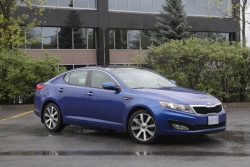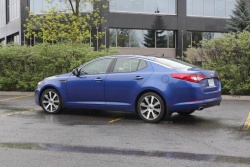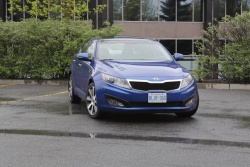 2011 Kia Optima EX Luxury. Click image to enlarge |
|
Related links
Manufacturer’s web site |
Review and photos by Chris Chase
Photo Gallery:
2011 Kia Optima
The concept of sibling rivalry isn’t limited to real-life families; it exists in automotive “families” too. It’s well-known in companies like General Motors, or the VW/Audi group, where the individual brands strive to come up with unique vehicles built around common platforms. Hyundai and Kia are relative newcomers to this concept, since Hyundai took a controlling interest in Kia about 15 years ago. In the years since then, the two brands have worked hard to establish their own identities within that corporate framework.
From Kia, the latest example of that comes to us as the 2011 Optima, a redesigned family sedan that, in Canada at least, sports a name as new as its sheet metal. This car replaces last year’s Magentis; the same car was sold in the U.S., but has always worn the Optima badge. For this market, it’s a better name attached to a much-improved car.
This one is based directly on the same platform that underpins the also-new-for-2011 Hyundai Sonata. Despite being corporate relatives and sharing many of the dirty bits that make up both cars, Hyundai and Kia are technically rivals in the marketplace, even if they each go after a slightly different driving demographic. In this case, the Optima is marketed to buyers looking for more sport in their sedan. Beyond the styling – the Kia is racier-looking than the Sonata – the differences are subtle, but they do exist.
  2011 Kia Optima EX Luxury. Click image to enlarge |
We took this car on a 2,700-kilometre road trip from our home in Canada’s capital to that “other” national capital, Washington, D.C. A long-distance trip is a good test for any car, but this one was trying not only for the vehicle, but for the driver, thanks to the massive amount of fast-moving traffic on the “beltway” ring roads that route cars and trucks around D.C. and nearby Baltimore, Maryland. That comes after three hours of slogging along I-81 and I-83 in Pennsylvania, which slice through the cities of Scranton, Wilkes-Barre, Harrisburg and York before crossing into Maryland. That Pennsylvania stretch looks innocuous enough on the map, but in reality, it’s three hours of truck drivers passing in the right lane, slow car drivers hogging the left, and on-ramps so poorly designed that many drivers are forced to come to a stop before they can merge onto the highway. By contrast, the busy D.C.-area beltways are nearly models of orderly driving, except for the locals’ tendency to follow too closely.
All that to say: a comfortable, well-sorted car is what you want on a drive like this. There might have been a time when I’d have scoffed at the idea of driving a Kia on such a long trip, but as other recent reviews have pointed out, this brand is light-years ahead of where it started when it first arrived in Canada in the late 1990s. Being owned by the go-getters at Hyundai doesn’t hurt, of course.
Kia’s suspension engineers have found a great balance between comfort and performance; the car absorbs bumps smoothly and without any untoward noises, and the suspension maintains its composure over mild mid-corner imperfections. The same can be said for the Sonata, for sure, but the Kia’s ride is firmer, and its cornering a little sharper. On the negative side, the brake pedal is soft and its feel doesn’t inspire confidence in hard stops. The steering is on the heavy side at low speeds, but its tuning allows for easy path corrections in crosswinds. The chunky, easy-to-grip steering wheel rim is a nice surprise in a family car.











